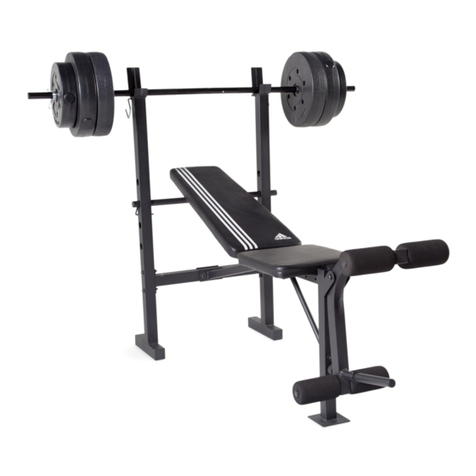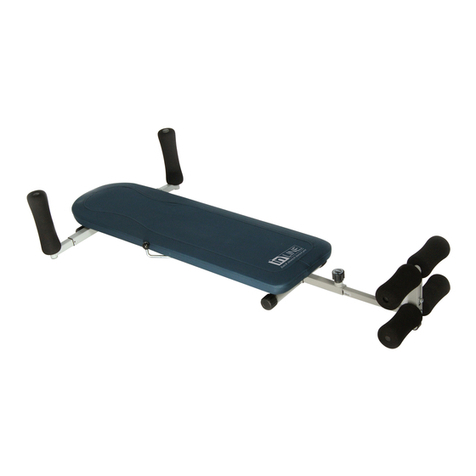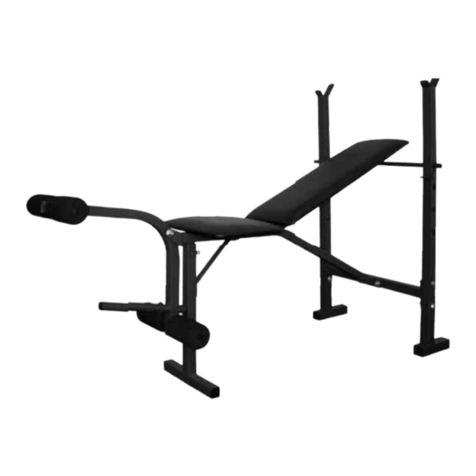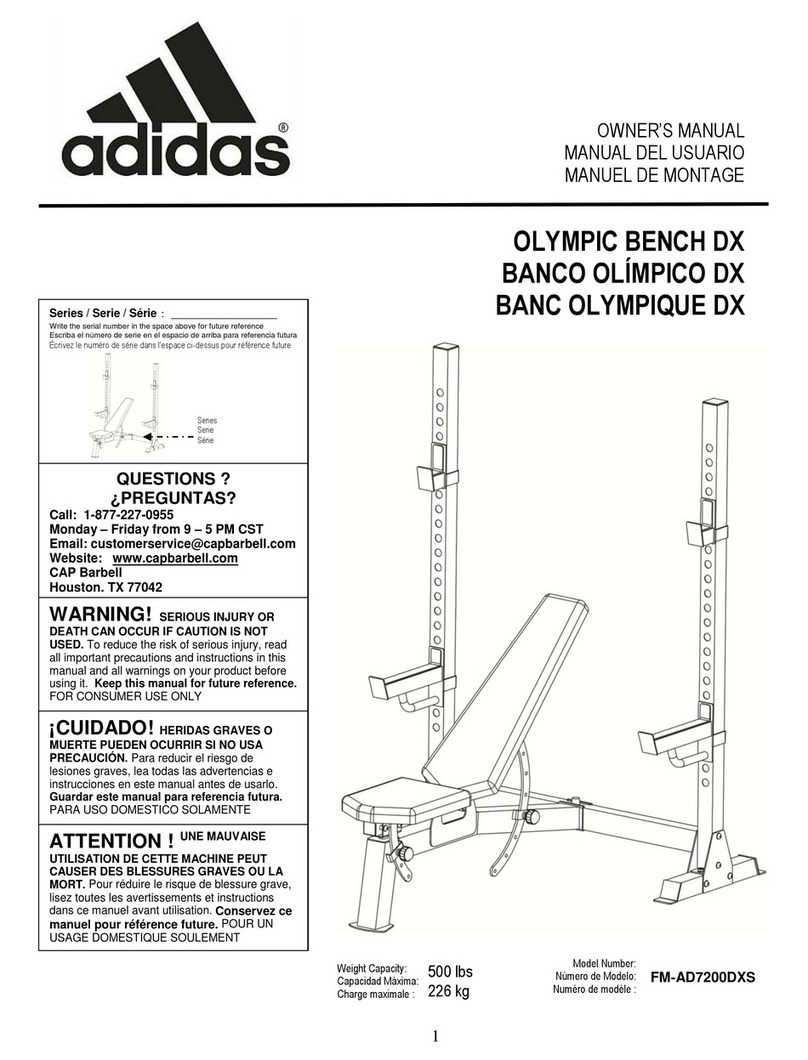
THE FOUR BASIC TYPES OF WORKOUTS
• Muscle Building
In order to increase the size and strength of your
muscles, you must push your muscles to a high per-
centage of their capacity. You must also progressively
increase the intensity of your exercise so that your
muscles will continually adapt and grow. Each individ-
ual exercise can be tailored to the proper intensity
level by changing the amount of weight used, or the
number of repetitions or sets performed. (A “repeti-
tion” is one complete cycle of an exercise, such as
one sit-up. A “set” is a series of repetitions performed
consecutively.)
The proper amount of weight for each exercise
depends upon the individual user. It is up to you to
gauge your limits. Select the amount of weight that
you think is right for you. Begin with 3 sets of 8 repeti-
tions for each exercise that you perform. Rest for 3
minutes after each set. When you can complete 3
sets of 12 repetitions without difficulty, increase the
amount of weight.
• Toning
To tone your muscles, you must push your muscles to
a moderate percentage of their capacity. Select a
moderate amount of weight and increase the number
of repetitions in each set. Complete as many sets of
15 to 20 repetitions as possible without discomfort.
Rest for 1 minute after each set. Work your muscles
by completing more sets rather than by using high
amounts of weight.
• Weight Loss
To lose weight, use a low amount of weight and
increase the number of repetitions in each set.
Exercise for 20 to 30 minutes, resting for a maximum
of 30 seconds between sets.
• Cross Training
In the pursuit of a complete and well-balanced fitness
program, many have found that cross training is the
answer. We recommend that on Monday, Wednesday
and Friday, you plan weight training workouts. On
Tuesday and Thursday, plan 20 to 30 minutes of aero-
bic exercise, such as cycling, running or swimming.
Rest from both weight training and aerobic exercise
for at least one full day each week to give your body
time to regenerate. By combining weight training with
aerobic exercise, you can reshape and strengthen
your body, plus develop a stronger heart and lungs.
PERSONALIZING YOUR EXERCISE PROGRAM
We have not specified an exact length of time for
each workout, or a specific number of repetitions or
sets for each exercise. It is very important to avoid
overdoing it during the first few months of your exer-
cise program, and to progress at your own pace. If
you experience pain or dizziness at any time while
exercising, stop immediately and begin to cool down.
Find out what is wrong before continuing. Remember
that adequate rest and a proper diet are also impor-
tant.
WARMING UP
Begin each workout with 5 to 10 minutes of light
stretching and exercise to warm up. Warming up pre-
pares your body for exercise by increasing circulation,
raising your body temperature and delivering more
oxygen to your muscles.
WORKING OUT
Each workout should include 6 to 10 different exercis-
es. Select exercises for every major muscle group,
with emphasis on the areas that you want to develop
the most. To give balance and variety to your work-
outs, vary the exercises from workout to workout.
Schedule your workouts for the time of day when your
energy level is the highest. Each workout should be
followed by at least one day of rest. Once you find the
schedule that is right for you, stick with it.
EXERCISE FORM
In order to obtain the greatest benefits from exercis-
ing, it is essential to maintain proper form.
Maintaining proper form means moving through the
full range of motion for each exercise, and moving
only the appropriate parts of the body. Exercising in
an uncontrolled manner will leave you feeling
exhausted. On the exercise poster accompanying this
manual, you will find photographs showing the correct
form for several exercises. A description of each exer-
cise is also provided, along with a list of the muscles
affected. Refer to the muscle chart on page 12 to find
the locations of the muscles.
The repetitions in each set should be performed
smoothly and without pausing. The exertion stage of
each repetition should last about half as long as the
return stage. Proper breathing is important. Exhale
during the exertion stage of each repetition and inhale
during the return stroke; never hold your breath. Rest
611
1. Before assembling this product, make sure
you have read and understand the information
in the box above.
Tap two 38mm Square Inner Caps (21) into the
open ends of the stabilizers on each Upright (1).
Attach the Crossbar (3) to the two Uprights (1)
with four M8 x 57mm Bolts (18), four M8 Washers
(16) and four M8 Nylon Locknuts (17). Make sure
the Crossbar (3) and both Uprights (1) are ori-
ented as shown. The decal on the Crossbar
must be facing up and the long bracket on the
weight rests must be on the side shown here.
2. Tap two 30mm Square Inner Caps (22) into the
open ends of the stabilizer on the Front Leg (8).
Attach the Front Leg (8) to the Frame (2) with the
M10 x 19mm Bolt (31).
2
1
21
8
2
31
22
22
3
17 Decal
16
16
18
18
16
17
17
1
21
Before beginning assembly, carefully read the
following information and instructions:
• Place all parts of the weight bench in a cleared
area and remove the packing materials; do not
dispose of the packing materials until assembly
is completed.
• Read each assembly step before you begin.
• For help identifying the small parts used in
assembly, use the PART IDENTIFICATION
CHART on the previous page. Note: Some
small parts may have been pre-attached for ship-
ping purposes. If a part is not in the parts bag,
check to see if it has been pre-attached.
• Tighten all parts as you assemble them, unless
instructed to do otherwise.
• As you assemble the weight bench, make sure
that all parts are oriented as shown in the
drawings.
THE FOLLOWING TOOLS (NOT INCLUDED)
ARE REQUIRED FOR ASSEMBLY:
• Two (2) adjustable wrenches
• One (1) phillips screwdriver
• One (1) rubber mallet
• Lubricant, such as grease or petroleum jelly,
and soapy water will also be needed
Assembly will be more convenient if you have the
following tools: A socket set, a set of open-end or
closed-end wrenches or a set of ratchet wrenches.
1Long Bracket
on Weight
Rests
Assembly Exercise Guidelines














